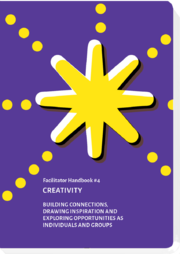|
|
| (6 intermediate revisions by the same user not shown) |
| Line 8: |
Line 8: |
| | | | |
| | [[File:Group-size.png | 20px | Group Size ]] 2-20 people | | [[File:Group-size.png | 20px | Group Size ]] 2-20 people |
| − |
| |
| − | [[File:Created-by.png | | 20px |Created By ]] [[User:Nils.zimmermann | nez]]
| |
| − |
| |
| | | | |
| | [[File:Keywords.png | 20px | Keywords ]] moderation, creativity, association | | [[File:Keywords.png | 20px | Keywords ]] moderation, creativity, association |
| Line 16: |
Line 13: |
| | ===Related:=== | | ===Related:=== |
| | * [[Unleashing Creativity]] | | * [[Unleashing Creativity]] |
| − | | + | <hr class="simpleline"> |
| | + | ===Also intersting:=== |
| | + | *[[Visualize data for a social purpose: mapping]] |
| | <hr class="simpleline"> | | <hr class="simpleline"> |
| | <div class=left-box> | | <div class=left-box> |
| Line 29: |
Line 28: |
| | </div> | | </div> |
| | <div class=methodpage-content> | | <div class=methodpage-content> |
| | + | |
| | ==Goal== | | ==Goal== |
| | Mindmaps bring structure and order thoughts. The help learners to store knowledge and to understand the connections between certain aspects. | | Mindmaps bring structure and order thoughts. The help learners to store knowledge and to understand the connections between certain aspects. |
| − | | + | <hr class=boldline> |
| | ==Steps== | | ==Steps== |
| | Ask learners to write a central topic or a leading question on a paper (here: Creativity). | | Ask learners to write a central topic or a leading question on a paper (here: Creativity). |
| | | | |
| − | [[File:Mindmapcompetendo.png | 550px | center]] | + | [[File:Mindmapcompetendo.png | 600px | center]] |
| | | | |
| | Encourage them to write the subordinate aspects or associations close to the central word. Try to follow a structural logic and connect the aspects with lines or different kind of arrows, like in the illustration. | | Encourage them to write the subordinate aspects or associations close to the central word. Try to follow a structural logic and connect the aspects with lines or different kind of arrows, like in the illustration. |
| | | | |
| | + | <hr class=boldline> |
| | + | <div class=left-box> |
| | + | ===Mapping: Resources=== |
| | + | <i class="far fa-map" style="font-size: 54px; color: #ccc; float:right;"></i> |
| | + | <noinclude>{{:Mapping: Resources}}</noinclude> |
| | + | </div> |
| | + | |
| | + | |
| | + | <hr class=boldline> |
| | + | |
| | + | <noinclude>{{: Block: Author Nils-Eyk Zimmermann }}</noinclude> |
| | + | <hr class=boldline> |
| | <div class=experience> | | <div class=experience> |
| | | | |
| | ==Experience== | | ==Experience== |
| − | Mindmaps might be developed on posters in a group process. They might help individuals in their research, or even be used as an electronical tool. | + | Mindmaps might be used on posters in a group process or used as an electronical tool. |
| | | | |
| − | However, as the tool is today a standard, one could look for alternatives such as Problem Trees, Ishikara Diagrams,... | + | However, as mindmaps are a standard today, one could look for alternatives such as Problem Trees, Ishikara Diagrams,... |
| | | | |
| | </div> | | </div> |
| Line 57: |
Line 69: |
| | | | |
| | </div> | | </div> |
| | + | [[Category:Method]] |
A mindmap is a good tool for ideation and documenting associations. It is often used in group processes and set down on paper, but can be used as well in electronic form and serve as a powerful creativity tool.
 10-20 minutes
10-20 minutes
 paper and pens
paper and pens
 2-20 people
2-20 people
 moderation, creativity, association
moderation, creativity, association
Related:
Also intersting:
Handbook #4
Creativity

N. Zimmermann, E. Leondieva, M. Gawinek-Dagargulia
Fourth Handbook for Facilitators: Read more
Goal
Mindmaps bring structure and order thoughts. The help learners to store knowledge and to understand the connections between certain aspects.
Steps
Ask learners to write a central topic or a leading question on a paper (here: Creativity).
Encourage them to write the subordinate aspects or associations close to the central word. Try to follow a structural logic and connect the aspects with lines or different kind of arrows, like in the illustration.
Mapping: Resources
OpenStreetMap
The Open global mapping project
online
uMap
Create your OpenStreetMap
online
This is not an atlas
Inspiration for artistic-activist-feminist maps (also a book)
online
Experience
Mindmaps might be used on posters in a group process or used as an electronical tool.
However, as mindmaps are a standard today, one could look for alternatives such as Problem Trees, Ishikara Diagrams,...
Variation
Applications for electronic mindmapping are especially effective, as everything can be rearranged or enlarged. The open source electronic tool FreePlane helps you to change, rearrange, add and connect ideas, words or phrases. Even complex knowledge can be arranged in such electronic maps.







